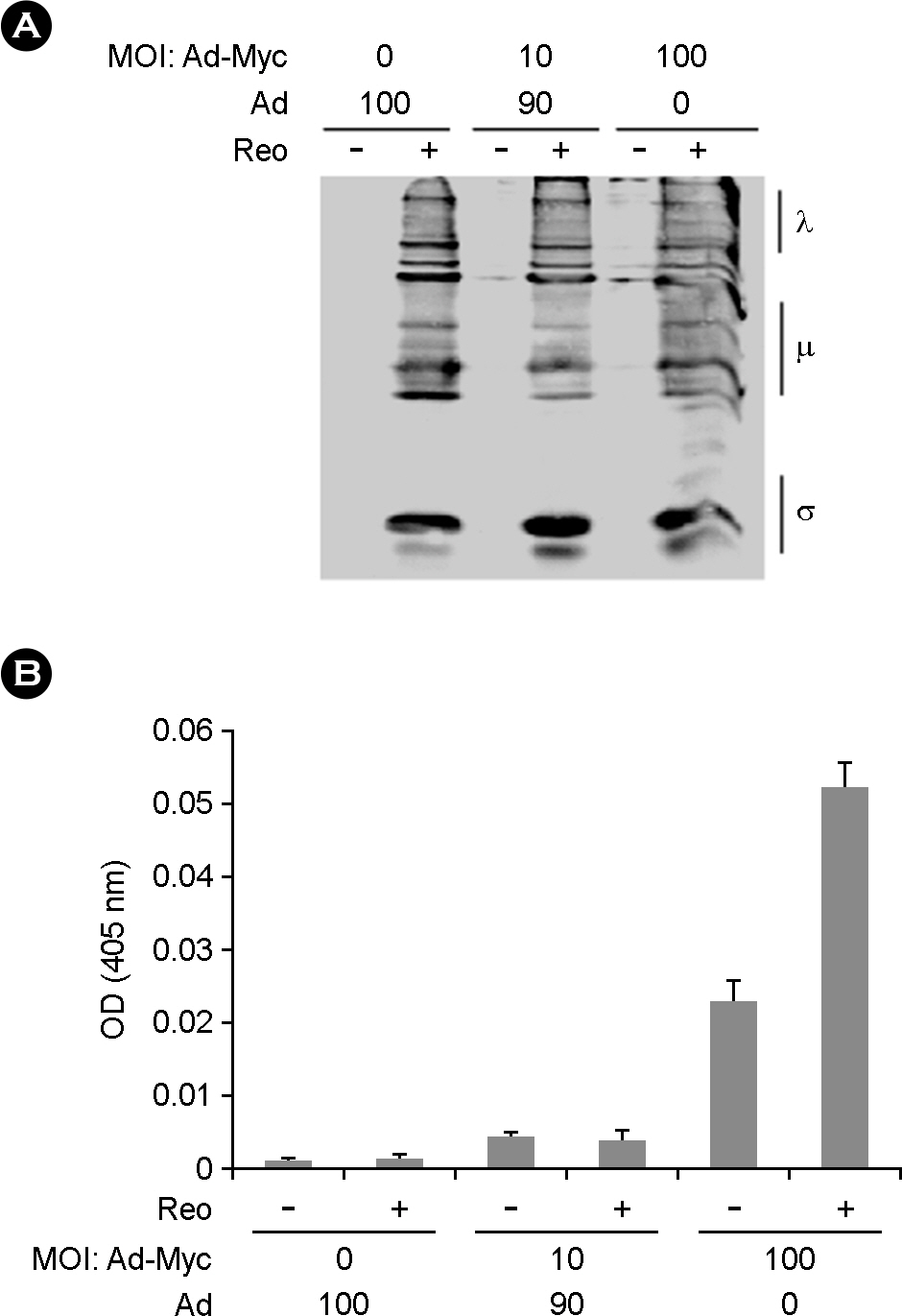J Bacteriol Virol.
2015 Jun;45(2):126-131. 10.4167/jbv.2015.45.2.126.
Reoviral Oncotropism Against c-Myc Overexpressing HS 68 Cells
- Affiliations
-
- 1Department of Medical Science, Dankook University College of Medicine, Cheonan, Korea. manbok66@dankook.ac.kr
- KMID: 2149212
- DOI: http://doi.org/10.4167/jbv.2015.45.2.126
Abstract
- Naturally occurring reoviruses are live replication-proficient viruses specifically infecting human cancer cell while sparing normal counterpart. Since the discovery of reoviruses in 1950s, reoviruses have shown various degrees of safety and efficacy in pre-clinical or clinical application for human anti-cancer therapeutics. I have recently shown that cellular tumor suppressor genes, such as p53, ATM (Ataxia telangiectasia mutated), and RB (Retinoblastoma associated), are important in determining reoviral oncotropism. Thus, it is interesting to examine whether the aberrancy of c-Myc expression, whose normal function also plays an important role in the maintenance of genomic integrity, could affect reoviral oncolytic tropism. Hs68 cells are non-tumorigenic normal cells and resistant to reoviral cytopathic effects. Importantly, I found that c-Myc overexpression in human HS68 cells effectively induced reovirus cytophatic effects compared to mock expressed cells as shown by the typical reoviral cytophathology and an increased level of caspase-3 activity. Taken together, overexpression of c-Myc could play an important role in determining reoviral oncolytic tropism.
Keyword
MeSH Terms
Figure
Reference
-
1). Tyler KL. Mammalian reoviruses. Fields BN, Knipe DM, Howley M, editors. Fields Virology. Philadelphia, USA: Lippincott-Raven;2001. p. 1729–45.2). Ramig RF, Cross RK, Fields BN. Genome RNAs and polypeptides of reovirus serotypes 1, 2, and 3. J Virol. 1977; 22:726–33.
Article3). Stoeckel J, Hay JG. Drug evaluation: Reolysin–wild- type reovirus as a cancer therapeutic. Curr Opin Mol Ther. 2006; 8:249–60.4). Kim M. Replicating poxviruses for human cancer therapy. J Microbiol. 2015; 53:209–18.
Article5). Roberts MS, Lorence RM, Groene WS, Bamat MK. Naturally oncolytic viruses. Curr Opin Mol Ther. 2006; 8:314–21.6). Wang G, Barrett JW, Stanford M, Werden SJ, Johnston JB, Gao X, et al. Infection of human cancer cells with myxoma virus requires Akt activation via interaction with a viral ankyrin-repeat host range factor. Proc Natl Acad Sci U S A. 2006; 103:4640–5.
Article7). Strong JE, Coffey MC, Tang D, Sabinin P, Lee PW. The molecular basis of viral oncolysis: usurpation of the Ras signaling pathway by reovirus. EMBO J. 1998; 17:3351–62.
Article8). Kuttler F, Mai S. c-Myc, Genomic Instability and Disease. Genome Dyn. 2006; 1:171–90.
Article9). Prochownik EV, Li Y. The ever expanding role for c-Myc in promoting genomic instability. Cell Cycle. 2007; 6:1024–9.
Article10). Prochownik EV. c-Myc: linking transformation and genomic instability. Curr Mol Med. 2008; 8:446–58.
Article11). Coschi CH, Dick FA. Chromosome instability and deregulated proliferation: an unavoidable duo. Cell Mol Life Sci. 2012; 69:2009–24.
Article12). Kim M, Williamson CT, Prudhomme J, Bebb DG, Riabowol K, Lee PW, et al. The viral tropism of two distinct oncolytic viruses, reovirus and myxoma virus, is modulated by cellular tumor suppressor gene status. Oncogene. 2010; 29:3990–6.
Article13). Kim M, Egan C, Alain T, Urbanski SJ, Lee PW, Forsyth PA, et al. Acquired resistance to reoviral oncolysis in Ras-transformed fibrosarcoma cells. Oncogene. 2007; 26:4124–34.
Article14). Nieminen AI, Partanen JI, Klefstrom J. c-Myc blazing a trail of death: coupling of the mitochondrial and death receptor apoptosis pathways by c-Myc. Cell Cycle. 2007; 6:2464–72.
Article15). Gabay M, Li Y, Felsher DW. MYC activation is a hallmark of cancer initiation and maintenance. Cold Spring Harb Perspect Med. 2014; 4.
Article16). Dang CV. MYC on the path to cancer. Cell. 2012; 149:22–35.
Article17). Spandidos DA, Dokianakis DN, Kallergi G, Aggelakis E. Molecular basis of gynecological cancer. Ann N Y Acad Sci. 2000; 900:56–64.
Article18). Aunoble B, Sanches R, Didier E, Bignon YJ. Major oncogenes and tumor suppressor genes involved in epithelial ovarian cancer (review). Int J Oncol. 2000; 16:567–76.
Article19). Hirasawa K, Nishikawa SG, Norman KL, Alain T, Kossakowska A, Lee PW. Oncolytic reovirus against ovarian and colon cancer. Cancer Res. 2002; 62:1696–701.20). ClinicalTrials.gov. [homepage on the Internet]. NCT- 01199263: Paclitaxel With or Without Viral Therapy in Treating Patients With Recurrent or Persistent Ovarian Epithelial, Fallopian Tube, or Primary Peritoneal Cancer. Available from:. www.clinicaltrials.gov/ct2/show/NCT-01199263.21). ClinicalTrials.gov. [homepage on the Internet]. NCT- 00602277: Viral Therapy in Treating Patients With Ovarian Epithelial Cancer, Primary Peritoneal Cancer, or Fallopian Tube Cancer That Did Not Respond to Platinum Chemotherapy. Available from:. www.clinicaltrials.gov/ct2/show/NCT00602277.
- Full Text Links
- Actions
-
Cited
- CITED
-
- Close
- Share
- Similar articles
-
- Immortalization of human embryonic fibroblasts by overexpression of c-myc and simian virus 40 large T antigen
- c-Myc-Induced Long Non-Coding RNA Small Nucleolar RNA Host Gene 7 Regulates Glycolysis in Breast Cancer
- Expression of Multidrug Resistance-associated Protein(MRP), c-myc and c-fos in L1210 Cells
- Stimulation of c-myc protooncogene expression by transforming growth factor a in human ovarian cancer cells
- Low-Dose Perifosine, a Phase II Phospholipid Akt Inhibitor, Selectively Sensitizes Drug-Resistant ABCB1-Overexpressing Cancer Cells



